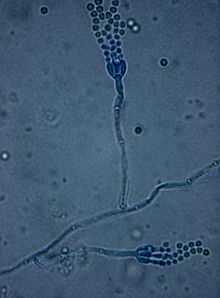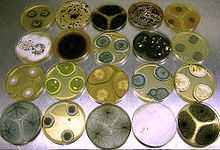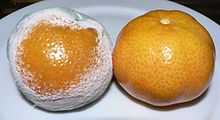Penicillium
| Penicillium | |
|---|---|
 | |
| Penicillium sp. | |
| Scientific classification | |
| Kingdom: | Fungi |
| Order: | Eurotiales |
| Family: | Trichocomaceae |
| Genus: | Penicillium Link (1809) |
| Type species | |
| Penicillium expansum Link (1809) | |
| Species | |
|
over 300 | |
| Synonyms[1] | |
|
Floccaria Grev. (1827) | |
Penicillium is a genus of ascomycetous fungi of major importance in the natural environment as well as food and drug production.
Members of the genus produce penicillin, a molecule that is used as an antibiotic, which kills or stops the growth of certain kinds of bacteria inside the body. According to the Dictionary of the Fungi (10th edition, 2008), the widespread genus contains over 300 species.[2]
Taxonomy and naming
The genus was first described in the scientific literature by Johann Heinrich Friedrich Link in his 1809 work Observationes in ordines plantarum naturales.[3] Link included three species—P. candidum, P. expansum, and P. glaucum—all of which produced a brush-like conidiophore (asexual fruiting structure). The common apple rot fungus P. expansum was selected as the type species.[4]
In a 1979 monograph, John I. Pitt divided Penicillium into four subgenera based on conidiophore morphology and branching pattern: Aspergilloides, Biverticillium, Furcatum, and Penicillium.[5]
Penicillium is classified as a genus of anamorphic fungi[2] in the division Ascomycota (order Eurotiales, class Eurotiomycetes, family Trichocomaceae).[6] The genus name is derived from the Latin root penicillum, meaning "painter's brush", and refers to the chains of conidia that resemble a broom.[7]
Characteristics

The thallus (mycelium) typically consists of a highly branched network of multinucleate, septate, usually colorless hyphae. Many-branched conidiophores sprout on the mycelia, bearing individually constricted conidiospores. The conidiospores are the main dispersal route of the fungi, and often are green in color.
Sexual reproduction involves the production of ascospores, commencing with the fusion of an archegonium and an antheridium, with sharing of nuclei. The irregularly distributed asci contain eight unicellular ascospores each.
Ecology
Species of Penicillium are ubiquitous soil fungi preferring cool and moderate climates, commonly present wherever organic material is available. Saprophytic species of Penicillium and Aspergillus are among the best-known representatives of the Eurotiales and live mainly on organic biodegradable substances. Commonly known as molds, they are among the main causes of food spoilage, especially species of subgenus Penicillium.[8] Many species produce highly toxic mycotoxins. The ability of these Penicillium species to grow on seeds and other stored foods depends on their propensity to thrive in low humidity and to colonize rapidly by aerial dispersion while the seeds are sufficiently moist.[9] Some species have a blue color, commonly growing on old bread and giving it a blue fuzzy texture.
Some Penicillium species affect the fruits and bulbs of plants, including P. expansum, apples and pears; P. digitatum, citrus fruits;[10] and P. allii, garlic.[11] Some species are known to be pathogenic to animals; P. corylophilum, P. fellutanum, P. implicatum, P. janthinellum, P. viridicatum, and P. waksmanii are potential pathogens of mosquitoes.[12] P. marneffei, which causes mortality in the Vietnamese bamboo rats, has become a common opportunistic infection of HIV-infected individuals in southeast Asia.[13]
Penicillium species are present in the air and dust of indoor environments, such as homes and public buildings. The fungus can be readily transported from the outdoors, and grow indoors using building material or accumulated soil to obtain nutrients for growth. Penicillium growth can still occur indoors even if the relative humidity is low, as long as there is sufficient moisture available on a given surface. A British study determined that Aspergillus- and Penicillium-type spores were the most prevalent in the indoor air of residential properties, and exceeded outdoor levels.[14] Even ceiling tiles can support the growth of Penicillium—as one study demonstrated—if the relative humidity is 85% and the moisture content of the tiles is greater than 2.2%.[15]
Some Penicillium species cause damage to machinery and the combustible materials and lubricants used to run and maintain them. For example, P. chrysogenum, P. steckii, P. notatum, P. cyclopium, and P. nalgiovensis affect fuels; P. chrysogenum, P. rubrum, and P. verrucosum cause damage to oils and lubricants; P. regulosum damages optical and protective glass.[16]
Economic value


Several species of the genus Penicillium play a central role in the production of cheese and of various meat products. To be specific, Penicillium molds are found in Blue cheese. Penicillium camemberti and Penicillium roqueforti are the molds on Camembert, Brie, Roquefort, and many other cheeses. Penicillium nalgiovense is used to improve the taste of sausages and hams, and to prevent colonization by other molds and bacteria.[17]
In addition to their importance in the food industry, species of Penicillium and Aspergillus serve in the production of a number of biotechnologically produced enzymes and other macromolecules, such as gluconic, citric, and tartaric acids, as well as several pectinases, lipase, amylases, cellulases, and proteases. Some Penicillium species have shown potential for use in bioremediation because of their ability to break down a variety of xenobiotic compounds.[18]
The genus includes a wide variety of species molds that are the source molds of major antibiotics. Penicillin, a drug produced by P. chrysogenum, was accidentally discovered by Alexander Fleming in 1929, and found to inhibit the growth of Gram-positive bacteria (see beta-lactams). Its potential as an antibiotic was realized in the late 1930s, and Howard Florey and Ernst Boris Chain purified and concentrated the compound. The drug's success in saving soldiers in World War II who had been dying from infected wounds resulted in Fleming, Florey and Chain jointly winning the Nobel Prize in Medicine in 1945.[19]
Griseofulvin is an antifungal drug and a potential chemotherapeutic agent[20] that was discovered in P. griseofulvum.[21] Additional species that produce compounds capable of inhibiting the growth of tumor cells in vitro include: P. pinophilum,[22] P. canescens,[23] and P. glabrum.[23]
Sexuality
Although most eukaryotes are able to reproduce sexually, as much as 20% of fungal species had been thought to reproduce exclusively by asexual means. However recent studies have revealed that sex occurs even in some of the supposedly asexual species. For example, sexual capability was recently shown for the fungus Penicillium roqueforti, used as a starter for blue cheese production.[24] This finding was based, in part, on evidence for functional mating type (MAT) genes that are involved in fungal sexual compatibility, and the presence in the sequenced genome of most of the important genes known to be involved in meiosis. Penicillium chrysogenum is of major medical and historical importance as the original and present-day industrial source of the antibiotic penicillin. The species was considered asexual for more than 100 years despite concerted efforts to induce sexual reproduction. However, in 2013, Bohm et al.[25] finally demonstrated sexual reproduction in P. chrysogenum
Penicillium marneffei, an AIDS-associated pathogen, was also previously assumed to reproduce exclusively by asexual means. This assumption was largely based on the highly clonal population structure of this species. However, recent work has revealed that the genes required for meiosis are present in P. marneffei.[26] This and other evidence indicated that mating and genetic recombination does occur in this species. It was concluded that P. marneffei is sexually reproducing, but recombination is most likely to occur across spatially and genetically limited distances in natural populations resulting in a highly clonal population structure.[26]
These findings with Penicillium species are consistent with accumulating evidence from studies of other eukaryotic species that sex was likely present in the common ancestor of all eukaryotes.[27][28] Furthermore, these recent results suggest that sex can be maintained even when very little genetic variability is produced.
Some species


- Penicillium albocoremium
- Penicillium aurantiogriseum
- Penicillium bilaiae, which is an agricultural inoculant
- Penicillium camemberti, which is used in the production of Camembert and Brie cheeses
- Penicillium candidum, which is used in making Brie and Camembert. It has been reduced to synonymy with Penicillium camemberti
- Penicillium chrysogenum (previously known as Penicillium notatum), which produces the antibiotic penicillin
- Penicillium claviforme
- Penicillium commune
- Penicillium crustosum
- Penicillium digitatum
- Penicillium echinulatum
- Penicillium expansum, a plant pathogen
- Penicillium funiculosum, a plant pathogen
- Penicillium glabrum
- Penicillium glaucum, which is used in making Gorgonzola cheese
- Penicillium italicum
- Penicillium lacussarmientei
- Penicillium marneffei, a thermally dimorphic species endemic in Southeast Asia, which presents a threat of systemic infection to AIDS patients
- Penicillium purpurogenum
- Penicillium roqueforti, which is used in making Roquefort, Danish Blue cheese, and also recently Gorgonzola
- Penicillium stoloniferum
- Penicillium ulaiense
- Penicillium verrucosum produces ochratoxin A
- Penicillium viridicatum produces ochratoxin
References
- ↑ "Penicillium Link 1809". MycoBank. International Mycological Association. Retrieved 2011-07-14.
- ↑ 2.0 2.1 Kirk, PM; Cannon, PF; Minter, DW; Stalpers, JA (2008). Dictionary of the Fungi (10th ed.). Wallingford, UK: CABI. p. 505. ISBN 978-0-85199-826-8.
- ↑ Link, JHF (1809). "Observationes in ordines plantarum naturales. Dissertatio I". Magazin der Gesellschaft Naturforschenden Freunde Berlin (in Latin) 3: 3–42.
- ↑ Samson, R.A.; Pitt, J.I. (1985). Advances in Penicillium and Aspergillus Systematics. Springer. ISBN 978-0-306-42222-5.
- ↑ Pitt, J.I. (1979). The genus Penicillium and its teleomorphic states Eupenicillium and Talaromyces. Academic Press. ISBN 978-0-12-557750-2.
- ↑ "Names record: Penicillium Link". Index Fungorum. CAB International. Retrieved 2011-07-14.
- ↑ Haubrich, W.S. (2003). Medical Meanings: A Glossary of Word Origins (2nd ed.). Philadelphia, Pennsylvania: American College of Physicians. p. 175. ISBN 978-1-930513-49-5. Retrieved 2013-02-03.
- ↑ Samson RA, Seifert KA, Kuijpers AF, Houbraken JA, Frisvad JC. (2004). "Phylogenetic analysis of Penicillium subgenus Pencillium using partial beta-tubulin sequences" (PDF). Studies in Mycology 49: 175–200.
- ↑ Pitt JI, Basílico JC, Abarca ML, López C. (2000). "Mycotoxins and toxigenic fungi". Medical Mycology 38 (Suppl 1): 41–46. PMID 11204163.
- ↑ Balgrie, B. (2003). Taints and Off-flavours in Food. CRC Press. p. 134. ISBN 978-1-85573-449-4. Retrieved 2013-02-03.
- ↑ Valdez JG, Makuch MA, Ordovini AF, Masuelli RW, Overy DP, Piccolo RJ. (2006). "First report of Penicillium allii as a field pathogen of garlic (Allium sativum)". Plant Pathology 55 (4): 583. doi:10.1111/j.1365-3059.2006.01411.x.
- ↑ da Costa, GL; de Moraes, AM; de Oliveira, PC (1998). "Pathogenic action of Penicillium species on mosquito vectors of human tropical diseases". Journal of Basic Microbiology 38 (5–6): 337–41. doi:10.1002/(SICI)1521-4028(199811)38:5/6<337::AID-JOBM337>3.0.CO;2-N. PMID 9871331.
- ↑ Ustianowski AP, Sieu TP, Day JN. (2008). "Penicillium marneffei infection in HIV". Current Opinion in Infectious Diseases 21 (1): 31–36. doi:10.1097/QCO.0b013e3282f406ae. PMID 18192783.
- ↑ Fairs, A.; Wardlaw, AJ (2010). "Guidelines on ambient intramural airborne fungal spores". Journal of Investigational Allergology and Clinical Immunology 20 (6): 490–98. PMID 21243933.
- ↑ Chang, JCS; Foarde, KK; Vanosdell, DW. (1995). "Growth evaluation of fungi (Penicillium and Aspergillus spp.) on ceiling tiles". Atmospheric Environment 29 (17): 2331 37. doi:10.1016/1352-2310(95)00062-4.
- ↑ Semenov SA, Gumargalieva KZ, Zaikov GE. (2003-08-01). Biodegradation and Durability of Materials Under the Effect of Microorganisms (New Concepts in Polymer Science). V.S.P. Intl Science. pp. 34–35. ISBN 978-90-6764-388-7.
- ↑ Marianski, S.; Marianski, A. (2009). The Art of Making Fermented Sausages. Seminole, Florida: Bookmagic. p. 47. ISBN 978-0-9824267-1-5. Retrieved 2013-02-03.
- ↑ Leitão, A.L. (2009). "Potential of Penicillium species in the bioremediation field" (PDF). International Journal of Environmental Research and Public Health 6 (4): 1393–417. doi:10.3390/ijerph6041393. PMC 2681198. PMID 19440525.
- ↑ Rifkind, D.; Freeman, G. (2005). The Nobel Prize Winning Discoveries in Infectious Diseases. London, UK: Academic Press. pp. 43–46. ISBN 978-0-12-369353-2. Retrieved 2013-02-03.
- ↑ Singh P, Rathinasamy K, Mohan R, Panda D. (2008). "Microtubule assembly dynamics: an attractive target for anticancer drugs". IUBMB Life 60 (6): 368–75. doi:10.1002/iub.42. PMID 18384115.
- ↑ De Carli, L.; Larizza, L. (1988). "Griseofulvin". Mutation Research 195 (2): 91–126. PMID 3277037.
- ↑ Nicoletti R, Manzo E, Ciavatta ML. (2009). "Occurrence and bioactivities of funicone-related compounds". International Journal of Molecular Sciences 10 (4): 1430–44. doi:10.3390/ijms10041430. PMC 2680625. PMID 19468317.
- ↑ 23.0 23.1 Nicoletti, R.; Buommino, E.; De Filippis, A.; Lopez-Gresa, M.; Manzo, E.; Carella, A; Petrazzuolo, M; Tufano, M.A. (2009). "Bioprospecting for antagonistic Penicillium strains as a resource of new antitumor compounds". World Journal of Microbiology 24 (2): 185–95. doi:10.1007/s11274-007-9455-y.
- ↑ Ropars J, Dupont J, Fontanillas E, Rodríguez de la Vega RC, Malagnac F, Coton M, Giraud T, López-Villavicencio M (2012). "Sex in cheese: evidence for sexuality in the fungus Penicillium roqueforti". PLoS ONE 7 (11): e49665. doi:10.1371/journal.pone.0049665. PMC 3504111. PMID 23185400.
- ↑ Böhm J, Hoff B, O'Gorman CM, Wolfers S, Klix V, Binger D, Zadra I, Kürnsteiner H, Pöggeler S, Dyer PS, Kück U (January 2013). "Sexual reproduction and mating-type-mediated strain development in the penicillin-producing fungus Penicillium chrysogenum". Proc. Natl. Acad. Sci. U.S.A. 110 (4): 1476–81. doi:10.1073/pnas.1217943110. PMC 3557024. PMID 23307807.
- ↑ 26.0 26.1 Henk DA, Shahar-Golan R, Devi KR, Boyce KJ, Zhan N, Fedorova ND, Nierman WC, Hsueh PR, Yuen KY, Sieu TP, Kinh NV, Wertheim H, Baker SG, Day JN, Vanittanakom N, Bignell EM, Andrianopoulos A, Fisher MC (2012). "Clonality despite sex: the evolution of host-associated sexual neighborhoods in the pathogenic fungus Penicillium marneffei". PLoS Pathog. 8 (10): e1002851. doi:10.1371/journal.ppat.1002851. PMC 3464222. PMID 23055919.
- ↑ Malik SB, Pightling AW, Stefaniak LM, Schurko AM, Logsdon JM (2008). "An expanded inventory of conserved meiotic genes provides evidence for sex in Trichomonas vaginalis". PLoS ONE 3 (8): e2879. doi:10.1371/journal.pone.0002879. PMC 2488364. PMID 18663385.
- ↑ Bernstein H and Bernstein C (2013). Evolutionary Origin and Adaptive Function of Meiosis. In Meiosis: Bernstein C and Bernstein H, editors. ISBN 978-953-51-1197-9, InTech, http://www.intechopen.com/books/meiosis/evolutionary-origin-and-adaptive-function-of-meiosis
- Harshberger, J.W. (1917). A Text-Book of Mycology and Plant Pathology. Churchill Livinstone.
External links
| Wikimedia Commons has media related to Penicillium. |
| Wikisource has the text of the 1921 Collier's Encyclopedia article Penicillium. |
- Samson, R. A. & J I Pitt Integration of Modern Taxonomic Methods For Penicillium and Aspergillus Classification (with an illustration on the cover)
- Asan, A. (2004, updated: January 2011). Aspergillus, Penicillium, and Related Species Reported from Turkey. Mycotaxon. 89 (1): 155-157. Link: http://www.mycotaxon.com/resources/checklists/asan-v89-checklist.pdf